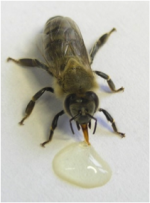Influence of honey ingredients on the development of the bee
Jointly financed by the European Union and the German federal states of Berlin, Brandenburg, Saxony-Anhalt, Saxony and Thuringia
Honey is an important economic factor for many beekeepers. As bee food, its ingredients can have a decisive influence, regardless of their origin, both on the development of the bee and on the survival of a bee colony over winter. Due to changes in our ecosystem, new plants are available as nectar suppliers to our native honey bees while others are disappearing. This also leads to changes in the composition of our honey. The question arises for many beekeepers whether or not all components in the nectar and the later honey make for a good resource allowing a fit bee colony to survive the winter.
Special larvae tests have been developed for infection experiments carried out at the LIB that allow for an observation of the development of bee larvae outside the colony (Genersch et al., 2005). This bioassay was able to be switched to honey as a sugar source in larval food in the project "Einfluss von Honiginhaltsstoffen auf die Entwicklung von Bienen" (influence of honey ingredients on the development of bees). The larvae reared on a mixture of honey and royal jelly exhibited a significantly better development than those reared on the previously used sugar variant. In the further course of the project, experiments will be carried out primarily with late summer honey.
"Hand-raised" bees: this bee was removed from the colony as it hatched and was raised on honey and royal jelly in an incubator. It is viable and has moved towards the source of food by itself.
- Authentication of honey from selected regions
- Sucrose degradation during the storage of honey: impact of time, temperature, enzyme activity and botanical origin
- Development of a new test method for the quality analysis of honey
- Influence of honey ingredients on the development of the bee
- Evidence for correlation between invertase activity and sucrose content during the ripening process of honey


